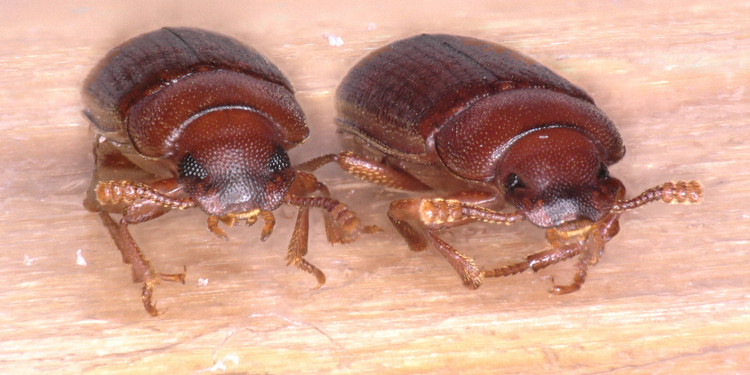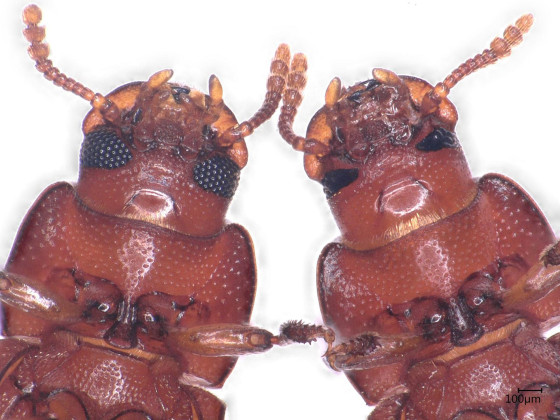
“Under stress, the buffer system is overloaded”
Since the discoveries made by the British naturalist Charles Darwin, one thing is clear: inherited differences between individuals are a decisive condition for evolutionary adaptation in organisms. Via the formation of proteins, they lead to different characteristics. In evolutionary biology these visible differences are called “phenotypes”. What Darwin could not know, however, is that there are also “hidden” (cryptic) genetic variations. A team led by Dr. Rascha Sayed and Prof. Joachim Kurtz from the Institute of Evolution and Biodiversity has now found evidence of such a variation and has identified its genetic basis. In this interview with Christina Hoppenbrock, Joachim Kurtz provides details of this mechanism.

It is above all the higher speed of evolution. Individuals whose characteristics in the prevailing environment lead to the best chances of survival and the most progeny have a selective advantage, better so-called fitness. They pass on these characteristics to the next generation, which enables adaptation to take place. But if such environmental changes occur rapidly, as we can currently observe as a result of man-made climate change, then the visible genetic variation might not suffice. It is then that the hidden, or cryptic, genetic variation can come into play. Cryptic genetic variations are not initially visible as different phenotypes. They come to light only under stressful conditions.
How does that function?
The basis is differences in proteins which don’t lead to different characteristics. The reason is that the organisms have a protection, so-called chaperones. These are proteins which help other proteins to fold properly, even when there are minor deviations from the norm.
In other words, correct folding is decisive for the proteins’ function?
Precisely. But under stress – for example, as a result of rapid environmental changes – this buffer system is no longer sufficient. It is overloaded. This is the moment when the genetic differences which are normally invisible take effect. The proteins fold differently, and previously invisible phenotypes can emerge.
Did you examine the HSP90 protein because it occurs particularly frequently in the cells of animals, plants, fungi and bacteria and is especially important?
Exactly. HSP stands for heat shock protein because, in the case of stress, more of it is produced – as in a heat shock – and becomes active. It is one of the most important folding helpers. But it also has other functions which have a comparable effect. For example, it also regulates the variation via epigenetic effects. What all this leads to is the creation of a kind of buffer. This ensures that cryptic genetic differences accumulate in the course of time and become visible under stress. In our experiments we artificially downregulated HSP90 and studied the effects in red flour beetles. We were thus able to make phenotypes visible which are not normally found: beetles with eyes only half as large as in normal beetles. We were surprised to find that, under normal conditions, these beetles had no disadvantages as regards fitness and, under permanent light, they even had some advantages. Previously, it was not known which genes were responsible for the different phenotypes which are regulated by HSP90. In our beetles we identified the gene upon which the reduced eye size is based.

They can. Most variants which become visible as a result of suppressing the function of HSP90 are negative. It is precisely this which was previously a criticism of the idea that there might be an advantage in evolution brought about by the release of cryptic variations. But some phenotypes which have disadvantages under most conditions can, under certain conditions, offer advantages.
Your study is a laboratory study. To what extent can the results be transferred to natural evolutionary processes?
The red flour beetle is a storage pest which is found in granaries and similar buildings where there is both permanent darkness and permanent light. Paradoxically, smaller eyes might be an advantage both in “cave conditions” and in conditions with permanent light. For one thing, because using the eyes costs energy. And, for another, permanent light disrupts natural daily rhythms – and we have the first indications that our beetles cope better with the small eyes. Actually, it’s not so much a question of reflecting the natural situation; however, our experiment shows what possibilities exist in principle for adapting to changed conditions.
This interview was published slightly abridged in the University newspaper wissen|leben, No. 7, 5 November 2025.
Literature: Rascha Sayed, Özge Şahin, Mohammed Errbii, Reshma, Robert Peuß, Tobias Prüser, Lukas Schrader, Nora K. E. Schulz & Joachim Kurtz (2025): HSP90 as an evolutionary capacitor drives adaptive eye size reduction via atonal. Nature Communications, DOI: 10.1038/s41467-025-65027-0
The study was carried out as part of the cooperative project entitled “Joint Institute for Individualisation in a Changing Environment (JICE)” undertaken by the Universities of Bielefeld and Münster and the Transregio Collaborate Research Ceentre SFB-TRR 212.
